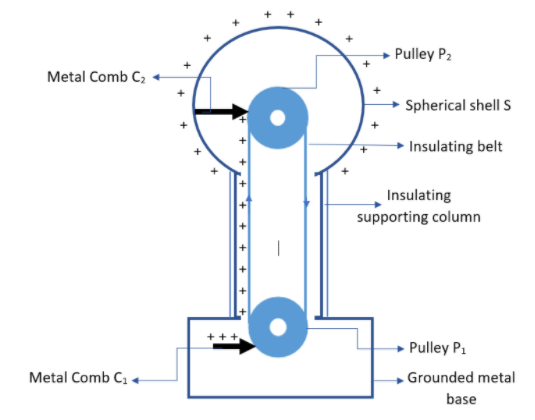
In case of a Van de Graff generator, the breakdown field of air is:
A).
B).
C).
D).
Answer
448.2k+ views
Hint: Note that the breakdown field of air is entirely an empirical quantity, so it cannot be obtained via theoretical calculations. Now, we know that air is an insulator and acts like a dielectric. But when a suitable high voltage is applied to it, it breaks its insulative properties and becomes conductive, and allows the electric charges to pass through it along its field lines. The electric field as a result of this breakdown is called the breakdown field. In such a case, determine what its value could be.
Complete step-by-step solution:
We know that a Van de Graff generator is basically an electrostatic generator which accumulates electric charges on a hollow metal shell by using an internally moving belt and is used to create very high electric potentials and high voltage direct current. Let us begin by looking at how it works.

A simple Van De Graff generator consists of an insulating belt usually made of rubber that runs over two moving pulleys
Now, we know that air is normally an excellent insulator. However, when it is stressed by a sufficiently high voltage, it can begin to break down and become partially conductive. This voltage is called the breakdown voltage of air, and the resultant electric field that it arises from is called the breakdown field. This breakdown field, at normal temperature and pressure, is empirically found to be
Therefore, the correct choice would be B.
Note: The voltage produced by most open-air Van de Graff machines are limited by arcing and corona discharge to about 5 megavolts. However, when placed in pressurized tanks of insulating gases, they can achieve potentials as high as 25 megavolts. Arcing is the phenomenon by which charges are able to jump through insulators or dielectrics by breaking them down, whereas corona is the electrical discharge caused by the ionization of the dielectric surrounding the conductor. Thus, arcing entails electrical discharge via flow of electrons, whereas corona entails electrical discharge via flow of ions.
Complete step-by-step solution:
We know that a Van de Graff generator is basically an electrostatic generator which accumulates electric charges on a hollow metal shell by using an internally moving belt and is used to create very high electric potentials and high voltage direct current. Let us begin by looking at how it works.

A simple Van De Graff generator consists of an insulating belt usually made of rubber that runs over two moving pulleys
Now, we know that air is normally an excellent insulator. However, when it is stressed by a sufficiently high voltage, it can begin to break down and become partially conductive. This voltage is called the breakdown voltage of air, and the resultant electric field that it arises from is called the breakdown field. This breakdown field, at normal temperature and pressure, is empirically found to be
Therefore, the correct choice would be B.
Note: The voltage produced by most open-air Van de Graff machines are limited by arcing and corona discharge to about 5 megavolts. However, when placed in pressurized tanks of insulating gases, they can achieve potentials as high as 25 megavolts. Arcing is the phenomenon by which charges are able to jump through insulators or dielectrics by breaking them down, whereas corona is the electrical discharge caused by the ionization of the dielectric surrounding the conductor. Thus, arcing entails electrical discharge via flow of electrons, whereas corona entails electrical discharge via flow of ions.
Recently Updated Pages
Master Class 12 Business Studies: Engaging Questions & Answers for Success

Master Class 12 English: Engaging Questions & Answers for Success

Master Class 12 Social Science: Engaging Questions & Answers for Success

Master Class 12 Chemistry: Engaging Questions & Answers for Success

Class 12 Question and Answer - Your Ultimate Solutions Guide

Master Class 12 Economics: Engaging Questions & Answers for Success

Trending doubts
Give 10 examples of unisexual and bisexual flowers

Draw a labelled sketch of the human eye class 12 physics CBSE

Differentiate between homogeneous and heterogeneous class 12 chemistry CBSE

Write a short note on Franklands reaction class 12 chemistry CBSE

Differentiate between insitu conservation and exsitu class 12 biology CBSE

What are the major means of transport Explain each class 12 social science CBSE




